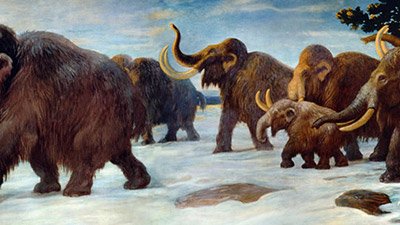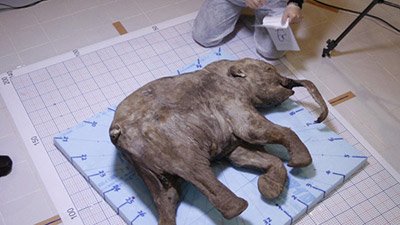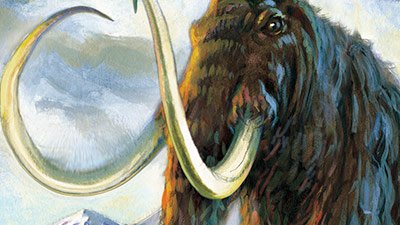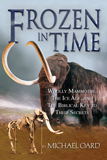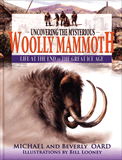Ice Age Animals
Ice Age Mammals
Mammoths, saber-toothed cats, and other giant mammals show up everywhere in popular culture. Many familiar animals possessed unusual traits during the Ice Age (hair on elephants?) or lived in unusual places (giant armadillos in Texas?). The main interest is that they were big. An eight-foot-long beaver—that’s impressive!
Woolly Mammoth Mystery
Why would the woolly mammoth and many other mammals even want to live in northern Siberia? What would they eat in the snowy tundra? As if the mystery isn’t deep enough, it appears that although they lived well for a time, they suddenly went extinct along with dozens of other large mammals and birds.
Megalonyx
One of the most common giant sloths known from North America is Megalonyx jeffersonii. Fossils of this extinct animal are found all over the continent in sedimentary deposits formed just prior to and during the Ice Age that occurred after Noah’s Flood.
News About Ice Age Animals
-
Sept. 27, 2018 from Ken Ham Blog
In only 10 years or so, you’ll be able (so we’re told) to see woolly mammoths, rhinos, cave lions, and long-extinct horses in a Siberian “Pleistocene Park”.
Articles About Ice Age Animals
-
April 18, 2021 from Answers Magazine
When you think of the Ice Age, you think of big critters like the woolly mammoth and giant sloth. Why was this huge size so helpful?
-
Dec. 27, 2016 from Answers in Depth
According to a report recently published in The Washington Post, researchers have uncovered the cranial remains of an enigmatic mammoth.
-
In-Depth ArticleWyoming Cave Traps Animals from the Ice Age until the Space AgeAug. 23, 2014 from Answers in Depth
Natural Trap Cave preserves a treasure trove of animals from the Ice Age until the 1970s.
-
Feb. 26, 2013 from Answers Magazine
When you think “sloth,” you usually think of the slow-moving, tree-hanging creatures from South America. But not all sloths lived in trees.
-
Woolly Rhinoceros Skull Found In HimalayasSept. 10, 2011 from News to Know
Pliocene rhino plowing pre-Pleistocene snow pleases paleontologists.
-
What Mean These Mastodons?Jan. 11, 2011
Varieties of fossilized mastodons, mammoths, and other elephants are widely distributed across North America and around the world.
-
What Happened to Woolly Mammoths?April 3, 2010
What happened to the woolly mammoths? It’s a whodunit (or, rather, a “what-done-it”) mystery of extinction that rivals the question of what did in the dinosaurs.
-
April 1, 2010 from Answers Magazine
Lyuba, a deceased baby woolly mammoth, has left frosty Siberia for a world tour.
-
Magazine Department ArticleMystery RockJan. 1, 2010 from Answers Magazine
Neither mom nor I can remember my age, but we both remember that rock!
-
Youth-Earth EvolutionismDec. 19, 2009 from News to Know
Mammoths didn’t die out that long ago: a creationist conclusion or the latest evolutionary idea?
-
A Mammoth FindOct. 24, 2009 from News to Know
In a special guest news analysis, creationist (and mammoth expert) Michael Oard considers the well-preserved mammoth “Lyuba.”
-
A Mammoth DiscoveryMay 4, 2009
The frozen remains of a baby mammoth discovered in 2007 are stirring up talk—especially because the mammoth is “remarkably preserved.”
-
April 1, 2009 from Answers Magazine
Mapping the genetic code of the woolly mammoth has opened the possibility of bringing one back to life.
-
Woolly Mammoth Genome Has Been MappedNov. 22, 2008
The genetic code of the woolly mammoth has finally been (mostly) mapped, and the question on (almost) everyone’s mind is: can we bring one back?
-
Book ChapterFrozen in TimeDec. 8, 2005 from Frozen in Time
The bones, tusks, and especially carcasses of millions of woolly mammoths frozen in the tundra of Siberia have excited the imaginations of children and scientists for hundreds of years.
-
Book ChapterThe Confusion of Elephant and Mammoth ClassificationOct. 1, 2004 from Frozen in Time
It is likely that all mammoths should be classified as one species, or at least within one biblical kind.
-
Book ChapterA Mammoth Number of Mammoth HypothesesOct. 1, 2004 from Frozen in Time
Efforts to understand the mysteries associated with the woolly mammoth have led to an abundance of hypotheses — all with mammoth problems.
-
Book ChapterWhy Live in Siberia?Oct. 1, 2004 from Frozen in Time
What drew millions of woolly mammoths to the far north where the winters are currently so fiercely cold and the summers so dangerously boggy? And what did they eat while they were there?
-
Book ChapterFrozen Mammoth Carcasses in SiberiaOct. 1, 2004 from Frozen in Time
Frozen mammoth carcasses have challenged our imagination for centuries. These carcasses sometimes come with skin, hair, and internal organs including the heart.
-
Book ChapterWoolly Mammoths—Flood or Ice Age?Oct. 1, 2004 from Frozen in Time
There is plenty of evidence that the woolly mammoths in Siberia, Alaska, and the Yukon and almost all other surficial sites in the Northern Hemisphere died after the Flood.
-
Book ChapterExtinction of the Woolly MammothOct. 1, 2004 from Frozen in Time
Climate change at the end of the Ice Age was the main cause of late Ice Age extinctions.
-
Book ChapterWere Siberian Mammoths Quick Frozen?Oct. 1, 2004 from Frozen in Time
Despite its appeal, there is much evidence against the quick-freeze hypothesis.
-
Book ChapterMammoths Thrive Early in the Post-Flood Ice AgeOct. 1, 2004 from Frozen in Time
We have developed the post-Flood Ice Age model based on the climatic aftermath of the Genesis flood. Now we are in a position to delve into the mysteries of the woolly mammoth.
-
Book ChapterThe Extinction WarsOct. 1, 2004 from Frozen in Time
The worst problem uniformitarian scientists encounter with the extinction of the Siberian woolly mammoths is that they disappeared not just in Siberia but everywhere at about the same time.
-
“Mr. Ice Age” Solves Woolly Mammoth MysteryNov. 11, 2000
The woolly mammoths have puzzled scientists for hundreds of years, but Ice Age researcher, Mike Oard, has proposed a radical solution in the latest issue of TJ.
-
Magazine ArticleMammoth Among the Pharaohs?Sept. 1, 1997, pp. 6–7
A mammoth in an Egyptian painting? Surely not—haven’t we been told in textbooks that mammoths definitely died out some 9,500 years ago?
-
Magazine ArticleMessages on StoneMarch 1, 1997, pp. 20–23
It was once held that mammoths and mastodons became extinct 30,000 to 40,000 years ago.
-
Magazine ArticleAre Mammoths Still Alive?Sept. 1, 1993, pp. 23–24
Two Russian scientists have found the remains of a group of woolly mammoths, on an island off northeastern Siberia, which give radiocarbon ages of less than 4,000 years.
Recommended Resources

Answers in Genesis is an apologetics ministry, dedicated to helping Christians defend their faith and proclaim the good news of Jesus Christ.
- Customer Service 800.778.3390
- © 2024 Answers in Genesis


